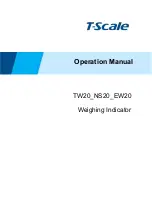
38
5. Inspect the battery case for any signs of out-gassing (causing white or blue/green corrosion) on
the contacts or in the battery case. If any is found use a cotton tipped swab and alcohol to clean
the battery compartment and contacts thoroughly and dry before installing any new cells.
Instrument damage due to out-gassing cells is NOT a manufacturer defect and repair is NOT
covered under our warranty.
6. Install the 8 replacement AA cells being sure to follow the battery polarity markings stamped in
the battery case. Remember they MUST all be the same type. DO NOT MIX CELL TYPES.
7. Replace the battery cover and stand bail and ensure it seats back on the back case correctly.
NO force should be required for correct seating.
8. Re-install the two retaining screws. Tighten snuggly, but do not over tighten.
9. Turn on the instrument ON and press the Meter Menu key, select Battery Menu, then select
Battery Type: and use the arrow keys and select the type of batteries used. This will ensure
that the low battery warnings will operate correctly. This is due to rechargeable and alkaline
batteries having different maximum voltage ratings.
Cleaning
The MRI-3000 is designed to operate in a variety of conditions and dirty environments.
Cleaning on regular basis should be accomplished with a soft, water moistened cloth. If dirt must be
removed, use a mild detergent (see recommended cleaners listed below) sprayed on the cloth first.
Rinse with a clean soft damp cloth moistened in water only.
Do NOT spray detergents or water directly on the instrument. Avoid using solvents or ammonia based
glass cleaners that can discolor the LCD protective cover.
Battery Compartment: Should one or more AA cells outgas in the battery compartment use a cotton
swab dipped in Alcohol (Isopropyl or rubbing alcohol) to remove both dry powdery and liquid leakage
completely. Pay particular attention to the battery contacts to ensure all leakage is removed. Dry any
wet areas or contacts with a dry cotton swab. NEVER reuse any AA cells indicating signs of out
gassing or leakage. Disposed of spent batteries in accordance with local hazardous material
regulations.
Belt Case: The soft case should be cleaned in the same manner as the instrument, but a soft brush
will help remove dirt, grime. Always remove the instrument first from the soft belt case first. Washing
in a machine or total immersion in soap and water is NOT recommended. Drying in a clothes drier or
oven is also NOT recommended. Dry the instrument and Belt Case separately overnight on a clean
cloth in fresh warm air.
The following are recommended cleaning agents for specific contamination:
Soil or light oily soil marks Household glass cleaner (non-ammonia
based) or 409® cleaner
Cable gel Orange based gel or liquid cleaner, non-abrasive
Tar, creosote or sticky adhesives WD40® followed with household cleaner NOTE: Always
spray cleaners or rinse water on the cloth NOT the instrument.






































